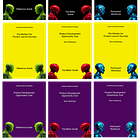Pre-Mortem Your Product Launch Before It Crashes
Using Inversion thinking with AI to identify failure points before they kill your product launch
Most teams predict what will go right, then scramble when things go wrong. Inversion thinking with AI helps you identify failure points before they kill your launch
A Workshop Kit is available for this article. Not yet a Coach-level Subscriber? Find out about the Brandable Workshops…
The Problem You're Solving
Your product launch is three weeks away. Marketing has the campaign ready. Engineering says the features are solid. Sales is already taking pre-orders. Everyone's excited about what could go right.
Then launch day hits. The payment system crashes under load. Customer support is flooded with feature requests that should have been obvious. The pricing strategy that looked brilliant in spreadsheets confuses actual customers. Your cross-functional team spent months planning for success but never systematically planned for failure.
Sound familiar? You're not alone. Most teams use "optimistic planning," imagining everything going smoothly, then reacting when reality disagrees.
What if you could predict these failures before they happen and actually prevent them?
🧠 The Thinking Model: Inversion
What it is: Inversion thinking means working backwards from failure to identify what could go wrong, then taking action to prevent those failures.
Origin: Popularized by Charlie Munger and used by successful investors, military strategists, and product teams to reduce blind spots.
Thinking shortcut:
"What would have to be true for this to fail spectacularly?"
"If I wanted this launch to crash, what would I do?"
Why Your Launch Planning Sucks (And How to Fix It)
Most people's approach:
Brainstorm what could go right
Create optimistic timelines and projections
Plan resources around best-case scenarios
Scramble to fix problems that "nobody saw coming"
The Inversion approach:
Systematically identify specific failure modes
Prioritize failures by impact and likelihood
Build prevention and mitigation strategies
Launch with confidence because you've already solved tomorrow's problems
🛠 Action Kit
The 3-Step Pre-Mortem Process
Step 1: Failure Scenario Generation
Instead of asking "What could go wrong?" (which gets vague answers), ask "What would make our biggest supporters say this launch was a disaster?" This forces specific, actionable failure scenarios.
Step 2: Cross-Functional Reality Check
Each department sees different failure modes. Engineering worries about technical debt. Marketing worries about messaging. Sales worries about pricing. AI helps surface these blind spots systematically.
Step 3: Prevention Priority Matrix
Not all failures are worth preventing. AI helps you identify which failures would be catastrophic vs. minor, and which are preventable vs. inevitable.

